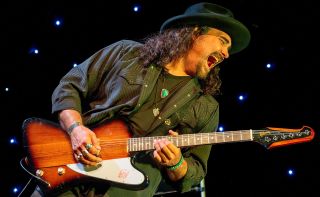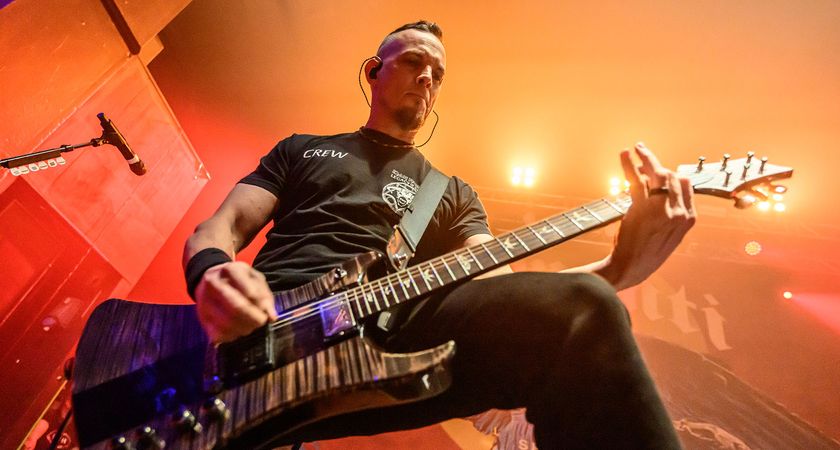“The first big gig for Starship was opening for Skynyrd in Florida in front of like 30,000 people. I had all these note-for-note solos, going, ‘God, I hope I nail these!’” Alastair Greene played sideman to rock greats – before he came back to the blues
The guitarist recalls the stress of his no rehearsal debut for Starship, learning lessons from Robin Trower and growing up with Seymour Duncan

After touring with The Alan Parsons Project and Starship, Alastair Greene decided to change his focus – and if his latest album, Standing Out Loud, is evidence, he was right to return to blues rock.
“I recommitted to the solo thing before the pandemic,” the 53-year-old tells Guitar World. “It’s been great. This record came in at No. 3 behind Slash on the blues chart, and we’ve been getting a lot of radio play.”
If Greene’s solo success finds him mentioned in the conversation alongside Eric Gales and Joe Bonamassa, then he’s earned it. “There’s really no shortcuts, man,” he says. “Social media has people sitting on their phones, hammering out 15-second videos.
“But if you really want a career making records and playing, you get out there and do it. You tour. When I was young I was like, ‘I’ll slip this demo to someone, and lightning will strike.’ But no – it’s a matter of keeping at it.”
Greene plans to remain in his seat at the blues rock table. “I feel confident in my ability at this point,” he says. “I’m comfortable with my guitar playing. I’m focusing on writing tunes with good riffs and hooks. Guitar isn’t taking a back seat, but there’s other things I’m working on.”
You opened for Robin Trower early in your career. What was that like?
“I got to open for him a few times. One of the times he called it his ‘first farewell tour’ in 2008 – he’s still out there doing it! What struck me was just how identifiable his tone is. So many people play Strats and Les Pauls through Marshalls, but I was like, ‘Wow, this guy playing that style is amazing.’”
Get The Pick Newsletter
All the latest guitar news, interviews, lessons, reviews, deals and more, direct to your inbox!
Not long after, you hooked up with the Alan Parsons Project. What was your rig like for that gig?
“When I started I was playing an Eric Clapton Strat, but I switched back to a Gibson Les Paul. A lot of the shows were fly dates, so I’d usually end up with a backline of 50-watt or 100-watt Marshall JCMs. We toured Germany a lot, and I ended up with a Hughes & Kettner endorsement for a while. I was actually in a bunch of ads!”
After Alan Parsons you joined Starship. One of your first gigs was in support of Lynyrd Skynyrd.
“With Starship I’d fly in with my Les Paul and pedalboard, and there’d be a backline. But there was a little more stress because there was no rehearsing for that gig – it was just fly in and kill it. The first big gig was opening for Skynyrd in Florida in front of like 30,000 people; I had all these note-for-note solos, going, ‘God, I hope I fucking nail these!’”

In 2017 you recorded a song by Billy Gibbons called Nome Zayne, which he’d never released. How did that come about?
“David Z, who produced that album, Dream Train, has worked with Billy and a lot of the blues rock guys. We had some demos from Billy, and David asked for permission to record that tune. I had to tune down my E string and put some insanely heavy strings on there. It was a totally different approach.”
While recording it, did you have Billy’s style and tone ringing in your ears?
“Absolutely. There were a couple of little arrangements that we made that gave nods to some of Billy’s stuff. With the solo I tipped my hat to him. He’s been a huge influence on my blues and Southern rock solo work – he’s one of the pillars of the house I’ve built.”
You opened for Walter Trout recently. How did you two meet?
“I met Walter when I was still with Alan Parsons. I guess he’d see stuff on social media and was aware of who I was; so when I met him he said, ‘I know you play guitar with Alan Parsons.’ I was like, ‘Yeah… but you’re fucking Walter Trout!’”
What have you learned from Walter?
“He’s been really supportive – one of the few mentors I’ve had. I’ve gotten to open shows for him in Germany and the UK, and I’ve gotten to sit in with him pretty much every time I’ve opened for him. One of the things you learn is there’s a reason that guys like him are where they’re at.

“They just lay it all out there every night and he’s 20 years older than me. It’s inspiring. What I’ve learned is that if you’re going to get up in front of people you just have to deliver. You have to make it happen. He’s still kicking ass.”
How would you describe your style as a solo artist compared to being a sideman?
“I’ve been pretty committed to my style for a long time. When I was a kid I was into my mom’s Beatles collection, then I got into Van Halen, Iron Maiden and blues rock. I always wanted to play some form of rock ‘n’ roll with a heavy blues influence.
I wouldn’t feel like an idiot getting onstage with anybody in blues or Southern rock; I would getting onstage with Yngwie Malmsteen
“Technique-wise, I feel pretty on my game. When I’m touring, once you get a few shows in, it’s like, ‘Okay, cool. I’ve got it all working.’ But in this genre, there’s everyone from B.B. King and early Eric Clapton to Eric Gales and Joe Bonamassa technique-wise. I feel like I fall somewhere in the middle of it all.
“It’s an interesting genre. There are these guys that kind of cross over into a different realm popularity-wise. That’s a matter of hard work and who you know, where you are and what the stuff is.

“At this point, I wouldn’t feel like a complete idiot getting onstage with anybody in blues or Southern rock; I would feel like an idiot getting onstage with Yngwie Malmsteen. But I feel pretty good about where I’ve gotten with my playing in this genre.”
What’s the secret to your tone?
“Definitely the Les Paul. I got one a chambered one in 2012. I wanted to not get emotionally attached, but it happened! And I’ve known Seymour Duncan since I was a kid – I grew up in Santa Barbara, California. So I don’t even think about it; I just put Seymour Duncan pickups in whatever guitar I get.”
How will you keep upping your guitar game as you move forward?
“I’m just going to keep writing, recording, putting out music, getting out there and playing it. Standing Out Loud, definitely steered the ship more toward the early ‘70s rock direction. I’m excited to keep going down that rabbit hole, keeping it blues-based.”
- Standing Out Loud is on sale now via Ruf Records.
Andrew Daly is an iced-coffee-addicted, oddball Telecaster-playing, alfredo pasta-loving journalist from Long Island, NY, who, in addition to being a contributing writer for Guitar World, scribes for Bass Player, Guitar Player, Guitarist, and MusicRadar. Andrew has interviewed favorites like Ace Frehley, Johnny Marr, Vito Bratta, Bruce Kulick, Joe Perry, Brad Whitford, Tom Morello, Rich Robinson, and Paul Stanley, while his all-time favorite (rhythm player), Keith Richards, continues to elude him.

“You got it!” Rare footage of Andy Summers teaching John Mayer how to play Message in a Bottle surfaces online

“I was very inspired by my Ibanez sister and the way she approaches her songwriting and her chords”: Nita Strauss reveals how Yvette Young inspired one of her favorite riffs she’s ever written











